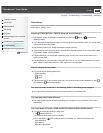
[Night Scene], [Sunrise&Sunset], [Fireworks], [Landscape], [Spotlight], [Beach] or [Snow] in [Scene
Selection]
The actual recording time for movies is less than the expected recording time
of the recording media.
Depending on the recording conditions, the time available for recording may be shorter, for example
when recording a fast moving object, etc.
The camcorder stops operating.
The temperature of your camcorder is extremely high. Turn off your camcorder and leave it for a
while in a cool place.
The temperature of your camcorder is extremely low. Turn off your camcorder and take it to a warm
place. Leave the camcorder there for a while, then turn on the camcorder.
If you keep applying vibration on the camcorder, recording may stop.
There is a time difference between the point when START/STOP is pressed
and the point that the recording movie is started or stopped actually.
On your camcorder, there may be a slight time difference between the point where you press
START/STOP and the actual point that recording movie starts/stops. This is not a malfunction.
The horizontal to vertical ratio of the movie (16:9 (wide)/4:3) cannot be
changed.
The horizontal to vertical ratio of high definition image quality (HD) movies is 16:9 (wide).
The auto focus does not function.
Set [Focus] to [Auto]. [Details]
The recording conditions are not suitable for auto focus. Adjust the focus manually. [Details]
SteadyShot does not function.
Set [ SteadyShot] to [Active] or [Standard], [ SteadyShot] to [On]. [Details] [Details]
Even if [
SteadyShot] is set to [Active] or [Standard], [ SteadyShot] to [On], your camcorder
may not be able to compensate for excessive vibrations.
Images cannot be recorded or played back correctly.
If you record and delete images repeatedly for a long time, the files on the recording media may
become fragmented and images cannot be recorded or played back correctly. After backing up the
images on other media, format the recording media on your camcorder. [Details]
The subjects passing by the screen very fast appear crooked.
This is called the focal plane phenomenon. This is not a malfunction. Because of the way the image
device (CMOS sensor) reads out image signals, the subjects passing by the lens rapidly might
appear crooked depending on the recording conditions.
Horizontal stripes appear on the images.
This occurs when recording images under a fluorescent lamp, sodium lamp, or mercury lamp. This is
203


















